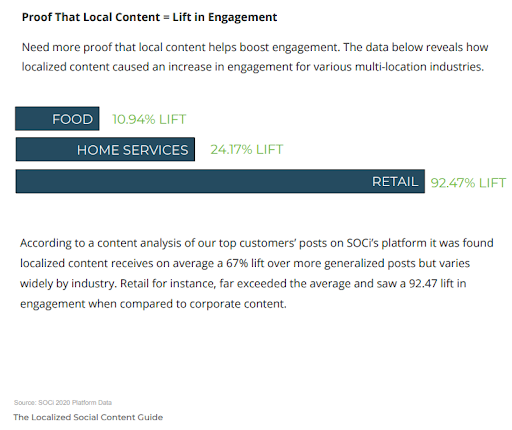
Individual store operators know this social media predicament well: Localized content and advertising drive better engagement than corporate content, but localized content takes staff time. And some technical know-how. And some marketing know-how. And some branding awareness. And, well, some way to not get swallowed up by it all because you’re in the retail business, not the social media business, even if posting your own hot and spicy chicken sandwich challenge sounds tempting.
Still, you can’t turn away from local, something that matters most in social media marketing. Localized content receives on average a 67% lift in engagement over more generalized posts, according to SOCi platform data.
Fortunately, by following best practices, you can enjoy a healthy boost to your social engagements with limited expertise and staff time without wandering off-brand. Here are the top difficulties brands face when posting localized social media content and advertising and how to overcome them.
Challenge No. 1: Finding a balance between who posts content — corporate or localLocal store operators use three approaches to posting content. The bummer is that the easiest is often the least effective:
- Centralized content is corporate content that is easy to share and represents the corporate brand but lacks local input. As a result, it isn’t as engaging with the local audience. It also limits the voice of the local franchise owner.
- Decentralized content is local content that typically drives higher value engagement but also requires local teams to produce the content. A local team that can do this well is a bonus.
- For most, hybrid content offers the best approach. This can mean your content has more of a local feel while still incorporating more general, corporate content. Additionally, a hybrid strategy can leverage local content and maintain the corporate brand by providing corporate templates that are easy to edit and localize. The hybrid approach can still prove challenging to keep local businesses posting regularly, so a word of advice: Help your local teams by providing a software tool that can create, edit, plan, and schedule content.
In terms of advertising, the hybrid approach can work for social ads at the national and local level, depending on the goals you are trying to reach. For example, if you’re looking to simply drive brand awareness, the use of corporate language and assets works great. However, if your goal is to increase traffic and sales at individual locations, your advertising language and accompanying graphics must be localized.
Localized content receives on average a 67% lift in engagement over more generalized posts, according to SOCi platform data.
Click To Tweet
The good news is there are new technologies, like SOCi, that enable ad placements to be centralized in one platform, yet localized upon delivery. A corporate team may better understand the intricacies of brand messaging, but it’s important that franchisees, for example, have the chance to give their local input on any content that is centralized within the social platform, or place additional budget behind top-performing posts or ads.
Challenge No. 2: Maintaining consistent brand messaging
In the push to post locally, individual business locations can struggle to maintain brand messaging. Local staff need to focus on doing quality work — whether it’s selling sporting goods or cleaning carpets. Brand messaging might fall to the wayside while they squeeze social media posts and online review responses into already busy days.
Lean into the hybrid approach. Distributed brand guidelines from corporate, including use of logo and mission statement, help ensure consistency across all locations and social channels. Additionally, finding a tool that can streamline approval processes and workflows is key – so the content can always be locally perfected, but also brand directed.
Similar tools can streamline advertising efforts, too. Branded ad templates, messaging, and approved store-specific ads created by individual franchisees can keep brand messaging on track. Franchisees, meanwhile, can create ads with location-specific offers or local community events.
Challenge No. 3: Knowing when and how often to postSo you know you want to take the hybrid approach and you recognize the importance of maintaining consistent brand messaging. Next comes getting into a consistent groove.
Retail brands alone see a 92% increase in engagements on localized content.
Click To Tweet
Multi-location marketers post an average of nine times monthly on Facebook, or about two posts a week, and one time per month on Google My Business, according to SOCi’s Localized Marketing Benchmark Report. Compared to posting bursts of content once in a while, having a regular cadence of content is crucial for a few reasons:
- A regular frequency of posts helps you reach more of your audience, as not all of your followers will see a random one-off post thanks to ever-evolving algorithms. By producing multiple posts within a week, you have a better chance of increasing your reach.
- This frequency allows you to see what type of content your audience is most likely to engage with and gives you insight into what you might want to adjust in future content.
- Through keeping an eye on historical data and continuing to optimize your content, you should be able to maximize your reach and engagement on every one of your social posts, increasing the effectiveness of your social content to help meet your overall digital marketing goals.
Finally, educate your teams on the strategy. Show what top brands do to set themselves apart. As noted below, retail brands alone see a 92% increase in engagements on localized content, which could be credited to teams aligning on the importance of posting engaging content to local pages regularly.

Get organized.
Managing content across limitless locations can prove challenging and local stores can find organizing and scheduling content intimidating. Using the right tool here can ease the pain. A technology solution can enable corporate teams to develop easy to follow content schedules for local teams to utilize, as well as pre-approved content libraries which makes the content development simple and streamlined.
Challenges OvercomeAt first glance, the steps to achieve successful localized digital marketing can feel like more of a stretch goal than a workflow reality. Time pressures. Local and corporate needs. Deciding who is actually going to do the work and when. But outlining a strategy, understanding what works, and giving your teams the tools and knowledge to gain their buy-in can elevate your brand, drive more engagement, and spur more sales.
Now that’s hot.
About the author
As CMO, Monica Ho is responsible for developing and leading SOCi’s marketing and communications functions as well as ensuring the company is uniquely positioned in the highly crowded marketing technology landscape. Monica’s tenure in the industry includes over 20 years of digital marketing, advertising, and research experience, including a solid foundation in sales, strategy, and data analytics. Prior to SOCi, she served as Global CMO at GroundTruth (formerly xAd, Inc), where she helped grow the business from an early stage startup to an award-winning global brand.
Well-regarded in the space, Monica has received numerous accolades and awards including being ranked one of The Most Powerful Women in Mobile Advertising (three years in a row) by Business Insider and one of the 100 most influential North American b2b tech marketers by Hot Topics. In addition to her role at SOCi, Monica serves on the advisory boards of several digital marketing and technology startups within New York, Texas and California.
The post Overcoming The Local-Corporate Social Media Posting Predicament appeared first on Convince & Convert.
* This article was originally published here
Comments
Post a Comment